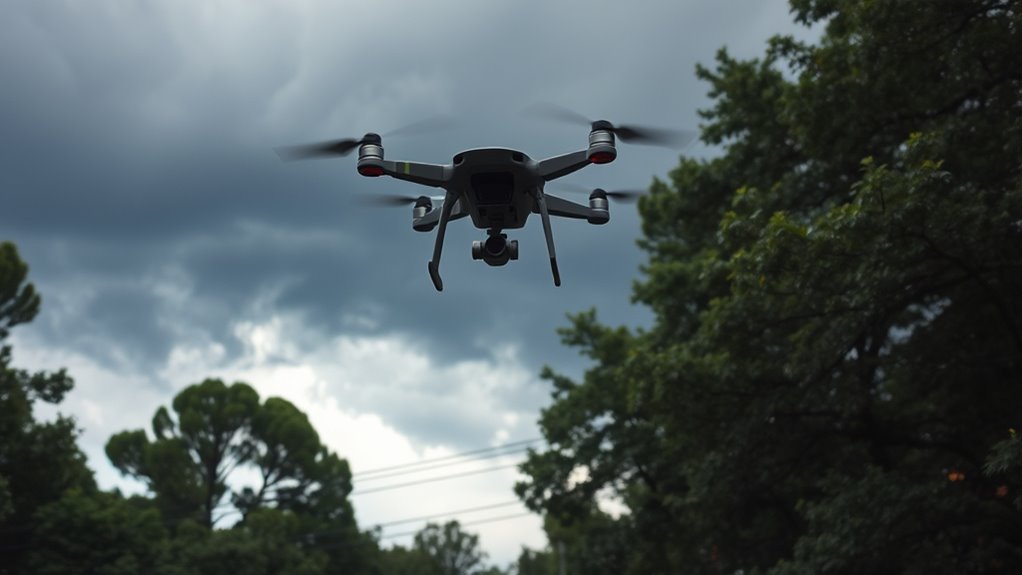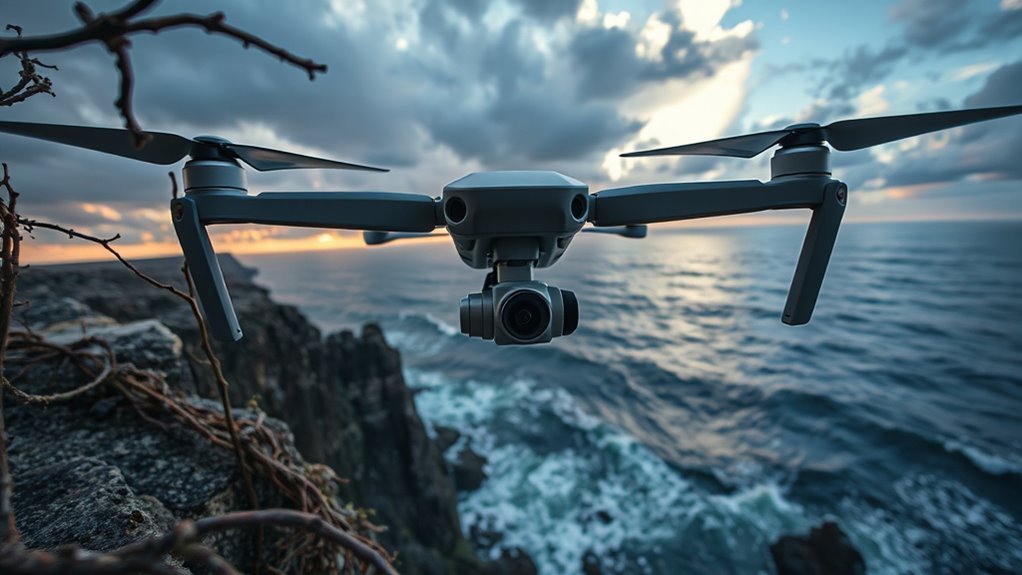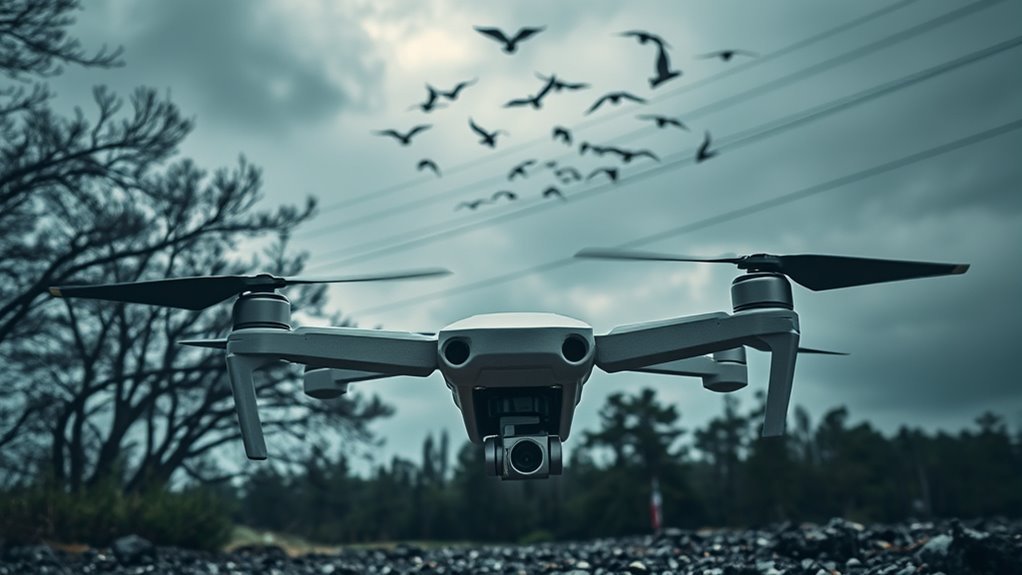Flying a drone can be difficult due to the complex airspace regulations, which demand strict compliance, especially in controlled zones. Weather conditions like wind, rain, and humidity affect performance and battery life. Steering through varied terrains presents challenges, from signal interference in urban areas to obstacles in forests. Additionally, safety considerations require thorough risk assessments and adherence to protocols. Understanding these factors will enhance your flying experience and help you operate more effectively in diverse environments.
Understanding Airspace Regulations

When you fly a drone, understanding airspace regulations is vital, as these rules dictate where and how you can operate your craft safely. Airspace classification divides the sky into different categories, each with specific rules. You’ll encounter controlled airspace, where regulatory compliance is mandatory, and uncontrolled airspace, which offers more freedom but still requires awareness of local laws.
Navigating these classifications can be complex, as each type may have unique altitude limits and operational restrictions. Failure to comply can lead to serious consequences, including fines or accidents. As a drone pilot, it’s important to familiarize yourself with these regulations to guarantee safe and responsible flight, allowing you to enjoy the freedom of aerial exploration without jeopardizing safety or legality.
Mastering Drone Technology

Understanding airspace regulations sets the groundwork for effectively mastering drone technology. To achieve ideal flight stability, you need to familiarize yourself with essential drone components. Each element, from the motors to the flight controller, plays a critical role in ensuring your drone operates smoothly. The advanced camera capabilities of the drone can also enhance your flying experience by enabling you to capture stunning visuals.
| Drone Component | Function |
|---|---|
| Flight Controller | Manages flight dynamics |
| Motors | Generate thrust and control |
| Propellers | Create lift and maneuverability |
| Battery | Powers the drone |
| GPS Module | Provides navigation capabilities |
Once you grasp how these components interact, you’ll gain the confidence to maneuver your drone with precision, releasing its full potential while adhering to regulations. Additionally, understanding swarm technology can enhance your ability to coordinate multiple drones effectively in a performance setting.
Weather Conditions and Their Impact

Although weather conditions can sometimes seem like an afterthought, they play an essential role in drone operation and safety. When you’re flying, wind turbulence can notably affect your drone’s stability. Even moderate winds can cause unexpected shifts, making control challenging. You might find that strong gusts lead to erratic flight paths, increasing the risk of accidents. Precipitation effects, such as rain or snow, can also pose serious issues. Wet conditions can impair visibility and lead to equipment malfunctions. Furthermore, moisture can affect battery performance, reducing flight time. Understanding these factors is vital for maintaining your drone’s performance. So, before you take off, check the weather forecasts and assess the conditions to guarantee a smooth and safe flying experience.
Navigating Different Terrains
As you navigate different terrains, the challenges can vary considerably, impacting your drone’s performance and stability. Terrain challenges like uneven surfaces or dense vegetation can complicate your flight path. Additionally, altitude variations can affect your drone’s lift and battery consumption, making it essential to adjust your settings accordingly. Understanding the operational capabilities of different drones, such as payload capacity, can also help in selecting the right equipment for specific environments. Battery capacity is another crucial factor that influences how far your drone can fly in diverse terrains.
| Terrain Type | Challenges | Solutions |
|---|---|---|
| Urban | Signal interference | Use GPS and visual aids |
| Forested | Obstructions and wind gusts | Fly at higher altitudes |
| Hilly | Altitude changes | Adjust altitude settings |
| Open Fields | Limited obstacles | Maintain steady speed |
Understanding these factors will help you make informed decisions, ensuring a smoother flying experience while maximizing your drone’s potential.
Safety Considerations and Risks
When flying a drone, safety considerations and associated risks must be prioritized to prevent accidents and guarantee a secure flying experience. Conducting a thorough risk assessment is essential before each flight. Evaluate the environment, weather conditions, and potential obstacles. Adhering to established safety protocols, such as maintaining line-of-sight and avoiding restricted airspace, further enhances your safety. Be aware of possible hazards, including collisions with other aircraft or structures, and the implications of losing control of your drone. Additionally, understanding the drone’s technical limitations can reduce risks. By proactively addressing these factors, you not only protect yourself and others but also foster a culture of responsible UAV operation that embraces the joy of flight with minimal risk. Utilizing drones with advanced features like AI-driven obstacle avoidance can significantly enhance safety during operations, as these systems leverage advanced AI integration to respond to potential threats in real-time.
Common Beginner Mistakes to Avoid
As a beginner, you might overlook critical aspects that can compromise your drone flight experience. Ignoring pre-flight checks, misjudging weather conditions, and overlooking local regulations are common pitfalls that can lead to accidents or legal issues. Understanding these mistakes and how to avoid them is essential for safe and effective drone operation. Additionally, being aware of how environmental conditions can impact flight performance will help you make informed decisions during your flying sessions. For instance, not considering your drone’s built-in GPS tracking features may hinder your ability to recover it if it loses signal.
Ignoring Pre-Flight Checks
Neglecting pre-flight checks can lead to critical issues during drone operation. A thorough equipment inspection is crucial for guaranteeing your drone’s performance and safety. By following a pre-flight checklist, you minimize risks and enhance your flying experience.
| Pre-Flight Checklist | Purpose | Importance |
|---|---|---|
| Battery Level Check | Guarantees sufficient power | Prevents mid-flight failures |
| Propeller Condition Check | Verifies structural integrity | Avoids crashes |
| GPS Functionality Check | Confirms navigation accuracy | Enhances flight stability |
| Firmware Update Check | Guarantees software reliability | Supports peak performance |
Incorporating these checks into your routine not only boosts your confidence but also maximizes your freedom in the skies. Don’t skip these crucial steps.
Misjudging Weather Conditions
Many new drone pilots underestimate the impact of weather conditions on flight performance, which can lead to dangerous situations. Misjudging wind patterns can cause instability, affecting your drone’s ability to maintain altitude and direction. For instance, strong gusts can push your drone off course or even lead to crashes. Additionally, precipitation effects can diminish visibility and increase the risk of equipment failure, especially if moisture penetrates sensitive components. Always check local weather forecasts and understand how temperature and humidity can influence your drone’s battery life and responsiveness. By acknowledging these factors, you’ll not only enhance your flying experience but also guarantee safer operations, allowing you the freedom to explore the skies without unnecessary risks.
Overlooking Local Regulations
Weather conditions are just one aspect of flying a drone that requires careful attention. However, overlooking local regulations can greatly hinder your freedom to fly. Each area has distinct local laws governing drone use, including restrictions on flight zones, altitude limits, and privacy concerns. Failing to understand these regulations can lead to legal repercussions or the confiscation of your equipment. Prioritizing regulatory compliance isn’t just about avoiding fines; it’s about ensuring safe and responsible flying. Always research the specific laws in your area before launching your drone. By doing so, you’ll not only enhance your flying experience but also contribute to the broader acceptance of drone technology. Empower yourself with knowledge, and fly freely within the law.
Frequently Asked Questions
How Do I Register My Drone With Authorities?
To register your drone, you’ll need to visit the appropriate authority’s website, complete the drone registration form, and pay any associated fees. Be sure to comply with all legal requirements to guarantee hassle-free flying.
What Are the Best Drones for Beginners?
Did you know that 60% of new drone users prefer beginner drones for ease of use? Look for models with stable flight features, user-friendly controls, and decent battery life to enhance your flying experience and freedom.
Can I Fly My Drone at Night?
Yes, you can fly your drone at night, but you must adhere to specific drone regulations. Make certain your drone has proper lighting for visibility and follow local laws to enjoy night flying safely and legally.
How Do I Choose the Right Drone Accessories?
Choosing the right drone accessories involves evaluating your needs. Consider drone batteries for longer flight times and compatible camera mounts for enhanced imaging. Prioritize quality and compatibility to guarantee peak performance and creative freedom during your flights.
What Should I Do if My Drone Crashes?
If your drone crashes, assess the damage first. Utilize crash recovery methods and consult your insurance options for coverage. Document everything for claims, ensuring you stay prepared for future flights and potential mishaps.

